
Parked in line at the border crossings to exit Serbia and enter Bosnia and Herzegovina are a load of coaches full of tourists. All needing to pass through ahead of us. A smart border guard comes aboard our coach this time. Speed being of the essence perhaps. “Passports, all passports!” He collects them in a decisive manner, ensuring that each is open at the photo page, before marching off to get them stamped.
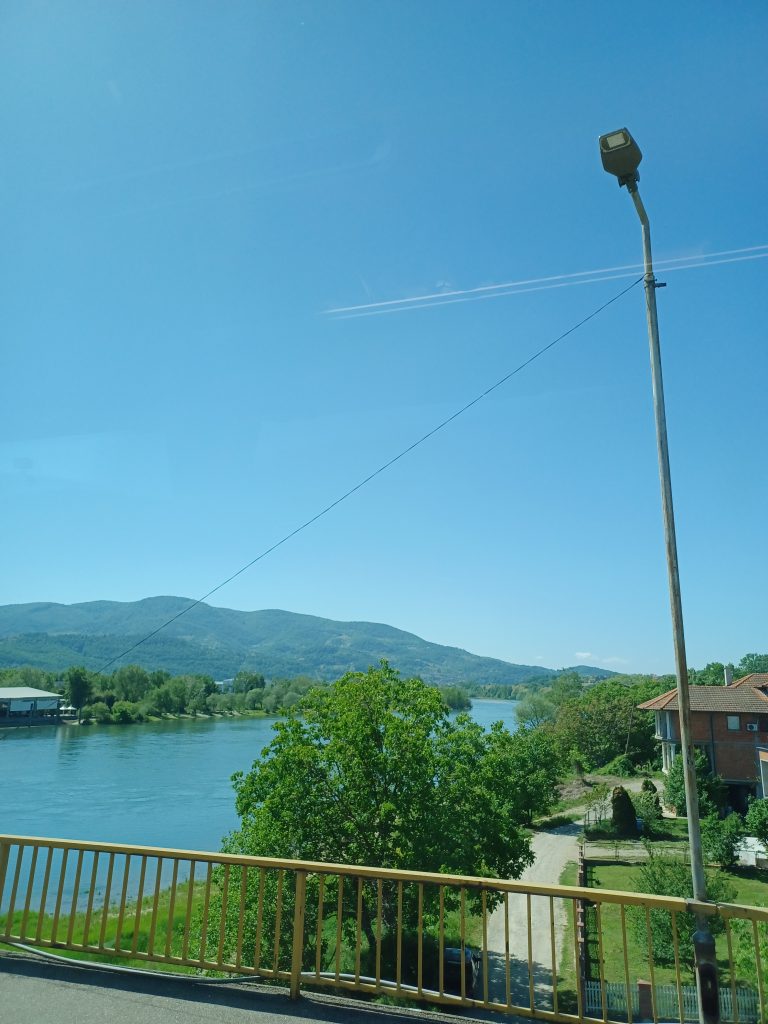
A redeeming feature of the long wait here is the view over the lovely Drina river and its bridge. This place is one of the areas where the Eastern Roman empire met the Western Roman empire, signified merely by a few houses and an Orthodox church on a hill. Diocletian (born in Croatia), it was, who initially divided the Roman empire into two halves ‒ Western and Eastern ‒ in the third century AD, being of the opinion that a mere one man could not govern such a huge empire efficaciously. The line ran through the Balkans, half of it ruled from Rome, Latin speaking, and half ruled from Byzantium, by then Constantinople, Greek speaking.
However, it was after the death of Theodosius (he who destroyed the Temple of Apollo at Delphi (see Greece, Part 3) in 395 AD, the last Emperor of both East and West, and who established the Nicene Creed for Orthodox Christians, that the empire really divided. Point of no return. His sons ruled east and west respectively. The Christian churches in East and West began to divide after this time too and in 1054 came the great East-West schism between Roman Catholicism and Eastern Orthodoxy. The final straw came during the fourth crusade in 1204, when western crusaders sacked Constantinople and desecrated the Hagia Sophia, the great Byzantine church. Only in the late 20th century and in recent years have attempts been made at reconciliation.
The guide endeavours to explain to the attentive the main issues. “Eastern Orthodoxy does not recognise the authority of the Pope in Rome over the Eastern patriarchs” he says. The Pope is merely ‘primus inter pares,’ first among equals. They believe that ecclesiastical matters should be decided by a Council of Bishops. I know little about it except that there are differences in theological beliefs and doctrine. In practical terms, the date of Easter is different, as Eastern Orthodox countries use the Julian calendar, while Western ones adopted the Gregorian.
As we leave Serbia and enter Bosnia and Herzegovina, the guide points out that the Serbian tricolour with its white eagles is still flying. Odd, as the national flag of Bosnia and Hercegovina is a yellow triangular shape, representing the shape of the country, on a dark blue background and several white stars. Apparently the Bosnian, Serbian and Croatian inhabitants could not agree on a national flag, so it was chosen for them, but each region seems to use its own.
Sarajevo
We arrive in Sarajevo. I had expected to see the tired remains of bombed out buildings but don’t, not at first anyway.
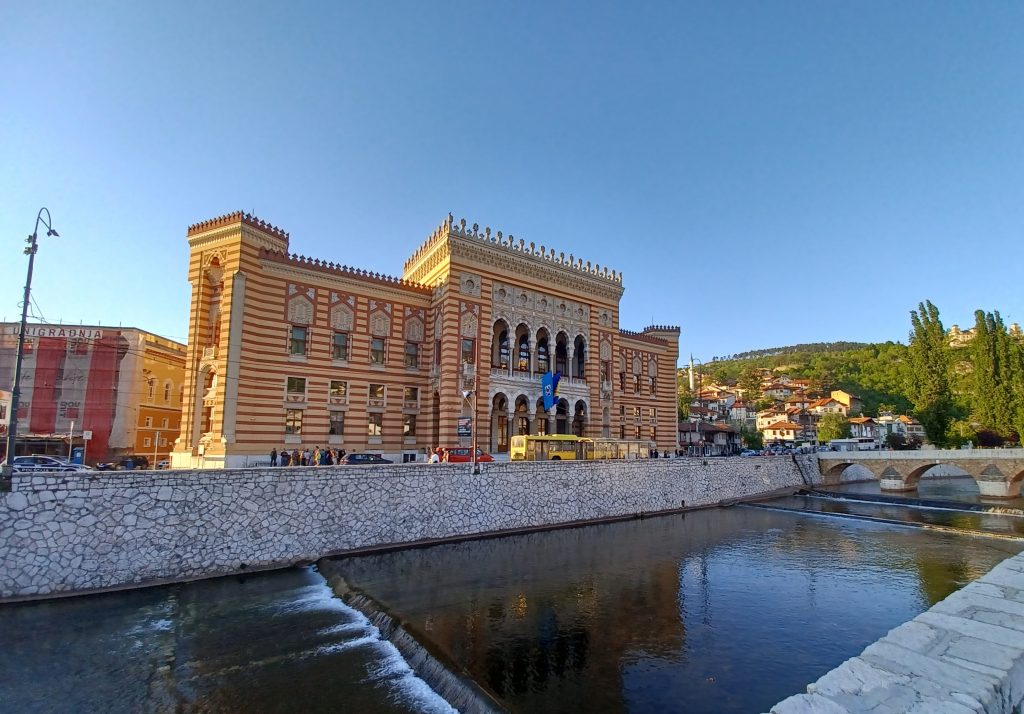
The coach pulls up by the Miljacka river, which runs through the city, and we are met by the local guide, a young lady with a piercing high-pitched voice and fair hair in plaits. We have a pep talk in front of the exotic rebuilt city hall, which is painted pale orange with dark orange horizontal stripes.
This Moorish style building was damaged during the nearly four year siege of Sarajevo between 1992 and 1995. Along with other cities in the country, Sarajevo was under a total economic and military blockade during this period. The city is situated in a basin surrounded by the hills of the Dinaric Alps and, during the siege, Serbian artillery rained down from those hills onto the unfortunates below. From where we stand we can see the cable car, which was built for the Winter Olympics in 1984, that ascends the hillslopes. These Olympic games were highly regarded, we are told, and today said cable car again takes visitors to the top. Must be a great view from there.
Princep Bridge
The Miljacka river is crossed by several old bridges. One of them is named the Latin Bridge, although for many years during the Yugoslav period (1918 – 1993), its name changed to Principov Most (Princip’s Bridge), named after Gavrilo Princep, a Bosnian Serb, who assassinated Archduke Franz Ferdinand, the heir to the Austro-Hungarian throne, and his wife, Sofia, on 28th June 1914. It was the Austro-Hungarians who declared war on the Kingdom of Serbia after the assassination, which sparked the First World War.
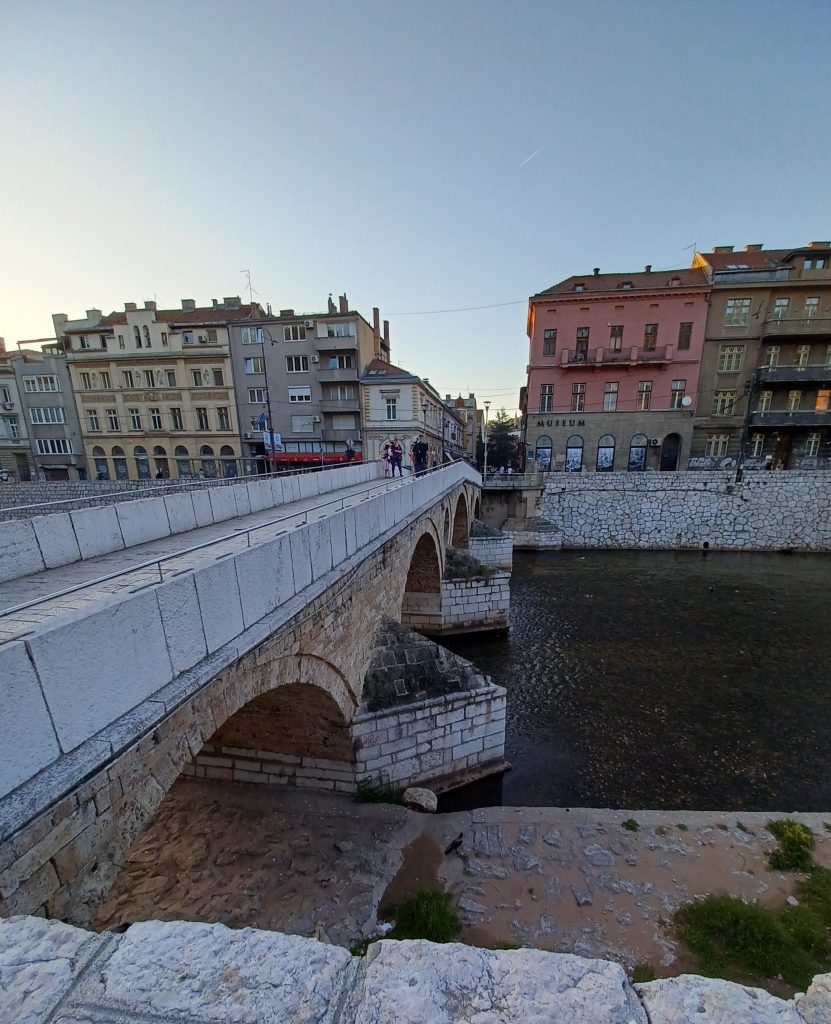
A stone tablet is fixed into the wall of the building, now a museum, on the street corner here giving this information. “The motorcade took the wrong route”, our guide tells us, “and happened to pass the spot where Princep was waiting”. “He shot the Archduke at close range”. We gaze at the large black and white photographs on the wall, which show the arrival of the royal couple, he in uniform and helmet with peacock feathers, she in long dress and jewels, in their motorcar. How the mighty have fallen.
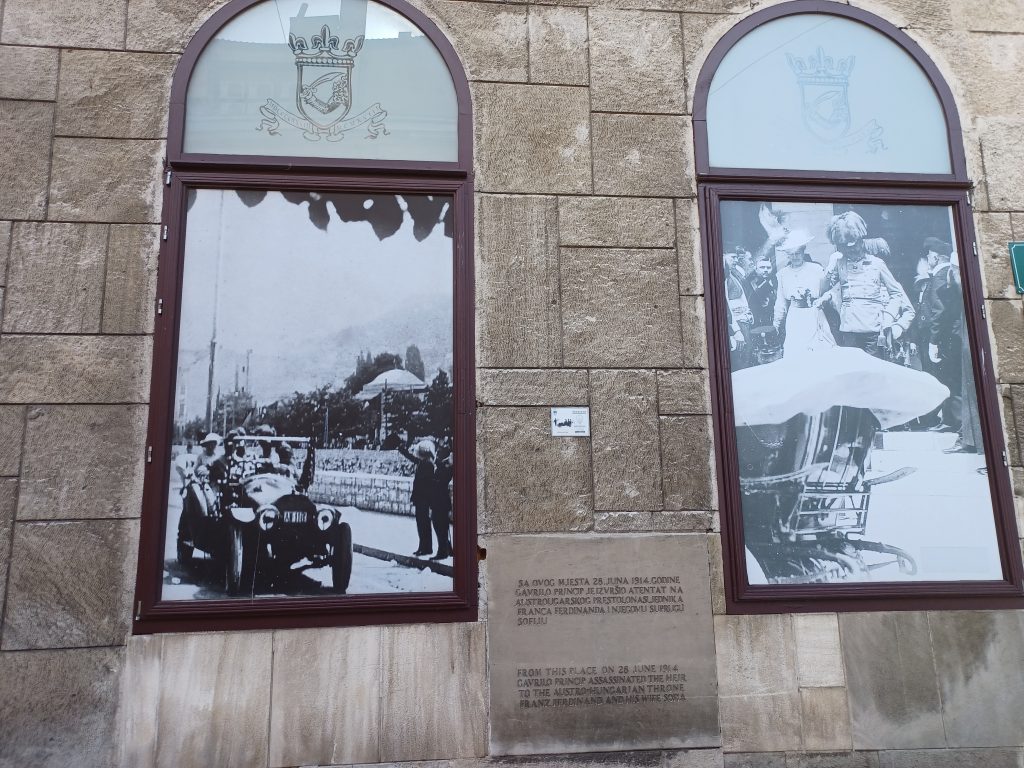
Gazi Huzrev Beg Mosque
From here we proceed to the Gazi Huzrev Beg mosque, built in 1530/31. Not particularly grand like those I have seen in Istanbul and other cities, but still impressive with its 45 metre high minaret and a lovely courtyard with a marble fountain, a ‘shadirwan’ in the middle where Muslims cleanse themselves before prayer. Its wooden roof was damaged during the siege of Sarajevo and rebuilt in 1997. Adjacent is a clock tower with four clock faces, one on each side, which shows lunar time, i.e. ‘a day ends at the moment of astronomical sunset’ when the clock face will show 12 O’clock, according to the information board, and ‘a new day begins at that very moment’. Useful for the faithful. Not seen one of those before, not knowingly anyway.
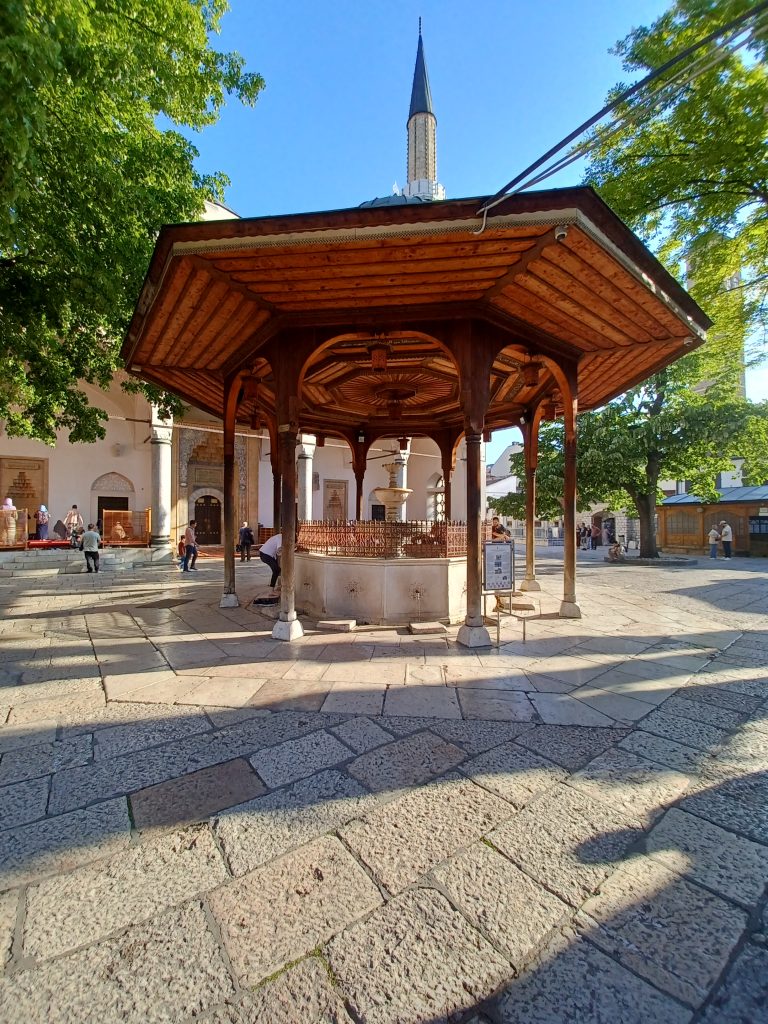
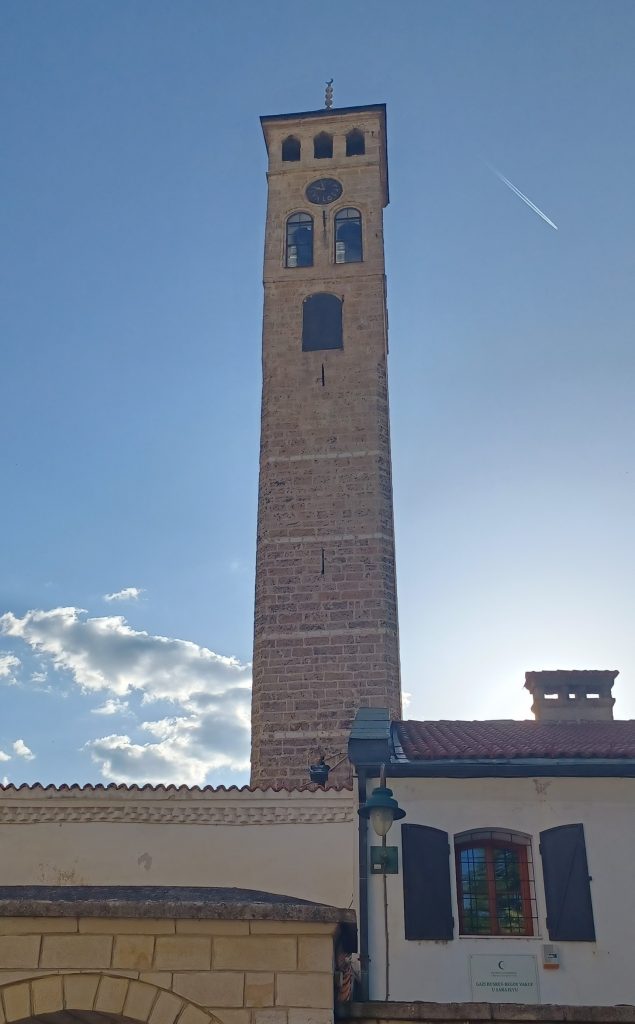
Sarajevo Meeting of Cultures
Further on, marked by a thick line and two compass points on the paving stones, is the spot in the city where East meets West. The words on the paving announce ‘Sarajevo Meeting of Cultures’. On the East side is the Ottoman area with its mosques and lively bazaars and cafés. On the West side are buildings of the Austro-Hungarian period with their solemn grandeur.
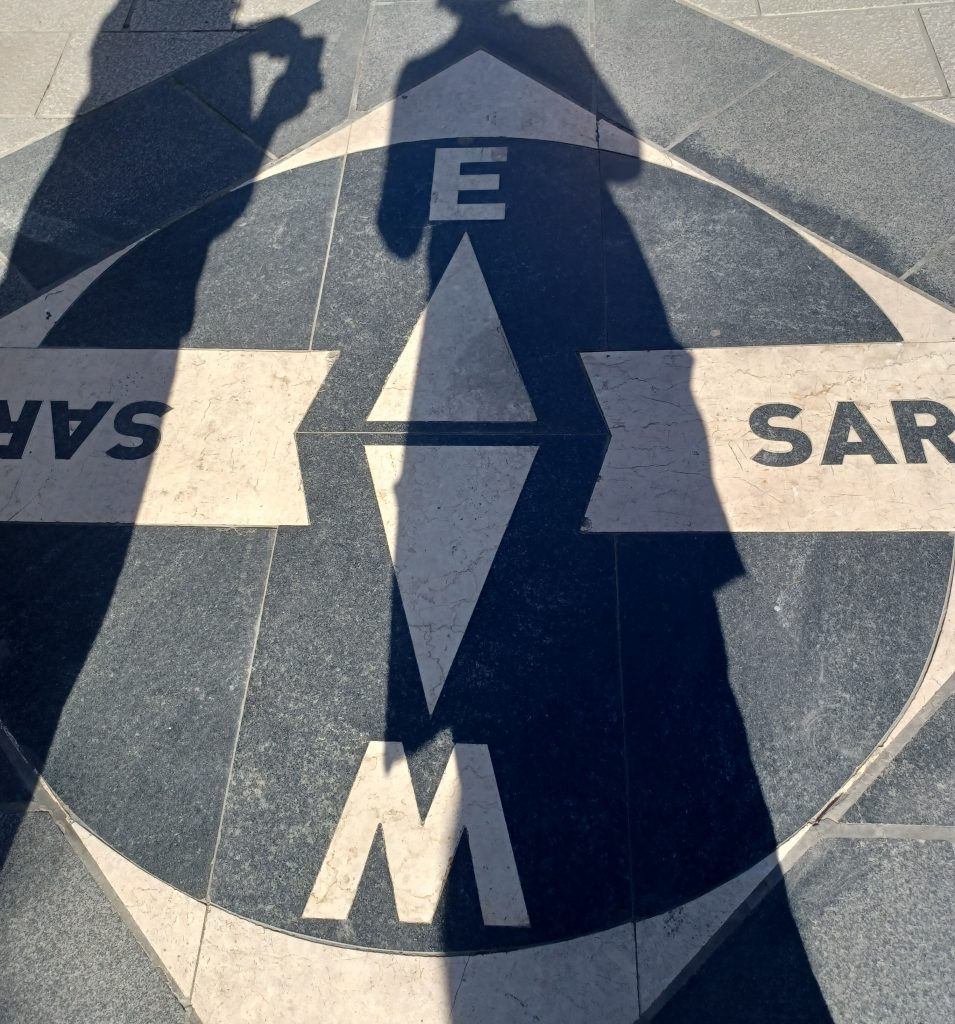
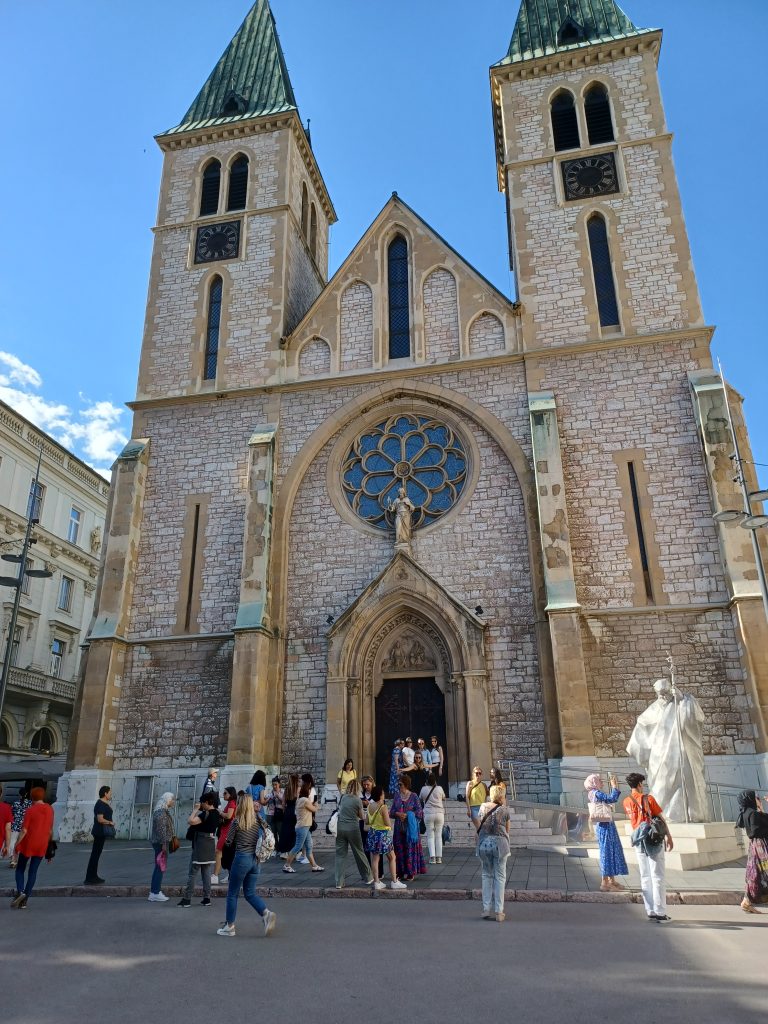
From the line is a short walk westwards to the Catholic Cathedral of Jesus’ Sacred Heart, built in the Neo Gothic style in 1889. It has two towers with short steeples one each side, and near the entrance a statue of Pope Jean-Paul II, who visited in 1997 after the war ended. “Pope Francis has also visited the Cathedral”, says our guide proudly “to send a message of peace and hope”. On the ground in front of the Cathedral is one of a number of ‘Sarajevo roses’, marking the spots where mortars fell and killed many civilians.
The holes have since been filled in with red resin, hence ‘roses’. A solemn reminder of the siege. Thus ends the walking tour.
I head back to the Ottoman eastern side and stumble upon a cobbled trading area housing old stables, now a restaurant, and a souvenir shop with colourful woven carpets, Turkish lamps, teapots and trinkets. I note a notice in support of Gaza at the entrance.
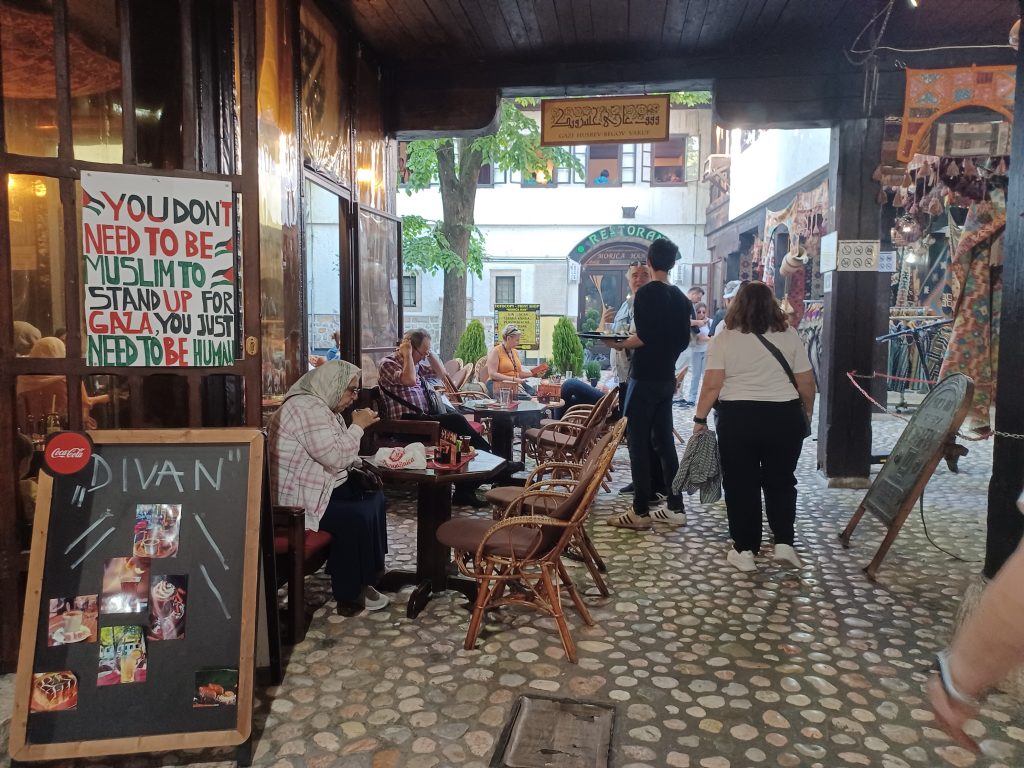
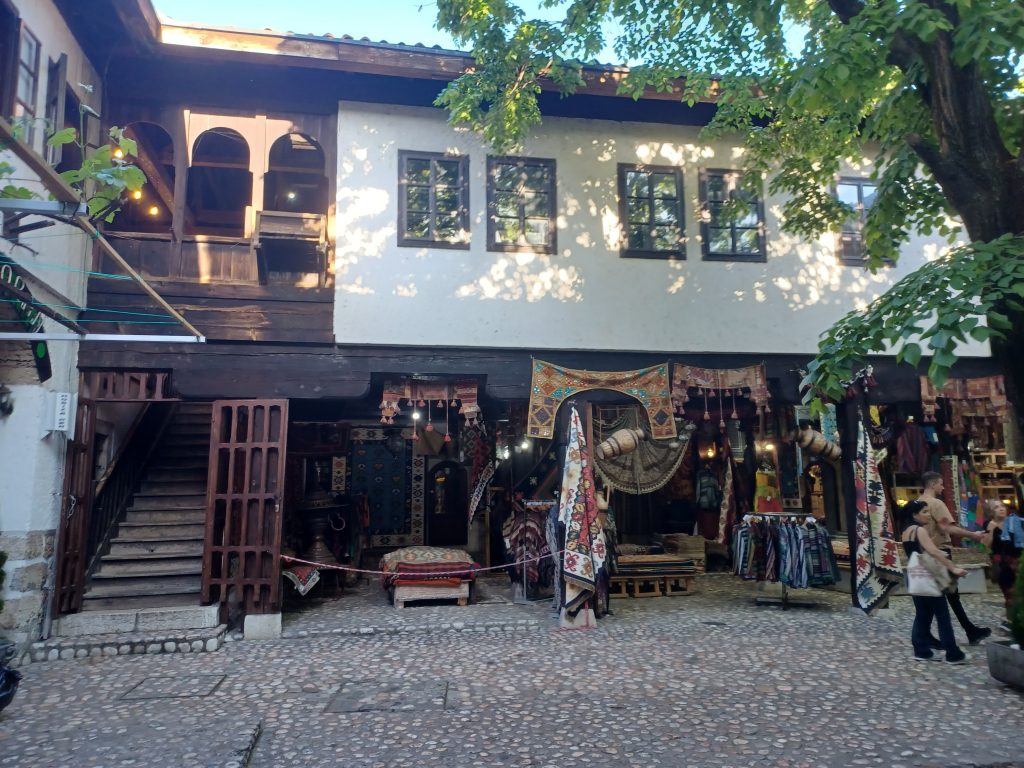
Then make my way to Baščaršija or Pigeon Square, full of pigeons. This is a picturesque square in the heart of Sarajevo, with cafés and stalls and a splendid old wooden fountain, the ‘Sebilj’, built in the Ottoman style in 1753. Not really a fountain as such. One can fill up one’s water bottle from a tap at the bottom of it. Legend has it that if one drinks the water from this fountain, one will return to Sarajevo. I didn’t but I might.
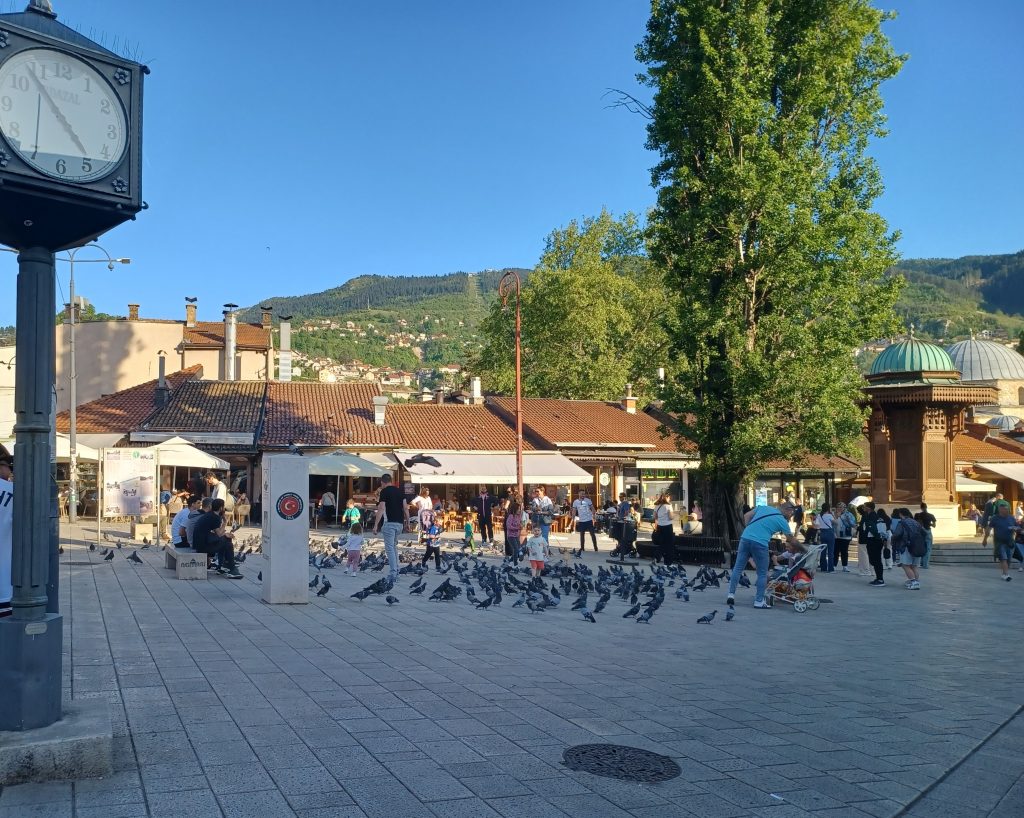
The old Orthodox church is here too, dedicated to the Archangels Michael and Gabriel. Handsome old stone building.
I am wondering what delicacy I can procure for lunch. The outdoor cafés are overflowing. Find an unassuming and less crowded little eatery on a less frequented back road out of the sun. Should be OK. Welcoming waiter. Traditional food is served here. I order five cevapi, minced meat in sausage shapes served in bread and with oodles of salad and onions on the side. Hmm. Justified my confidence.
Thence to the City Hall and over the bridge to a house, named ‘Inat Kuća’, The Spite House. This 18th century Ottoman house used to be located where the City Hall now stands but the Austro-Hungarian monarchy wished to build the City Hall on this particular spot on the north bank of the River Miljacka. The owner did not allow them to demolish his house but demanded that it be rebuilt brick by brick in another spot on the south bank and that he, moreover, should receive a bag of gold ducats. He got his wish. An example of ‘Bosnian stubbornness’, according to a signpost. The house is now a restaurant serving Bosnian dishes. Peep through the window. Looks authentic.
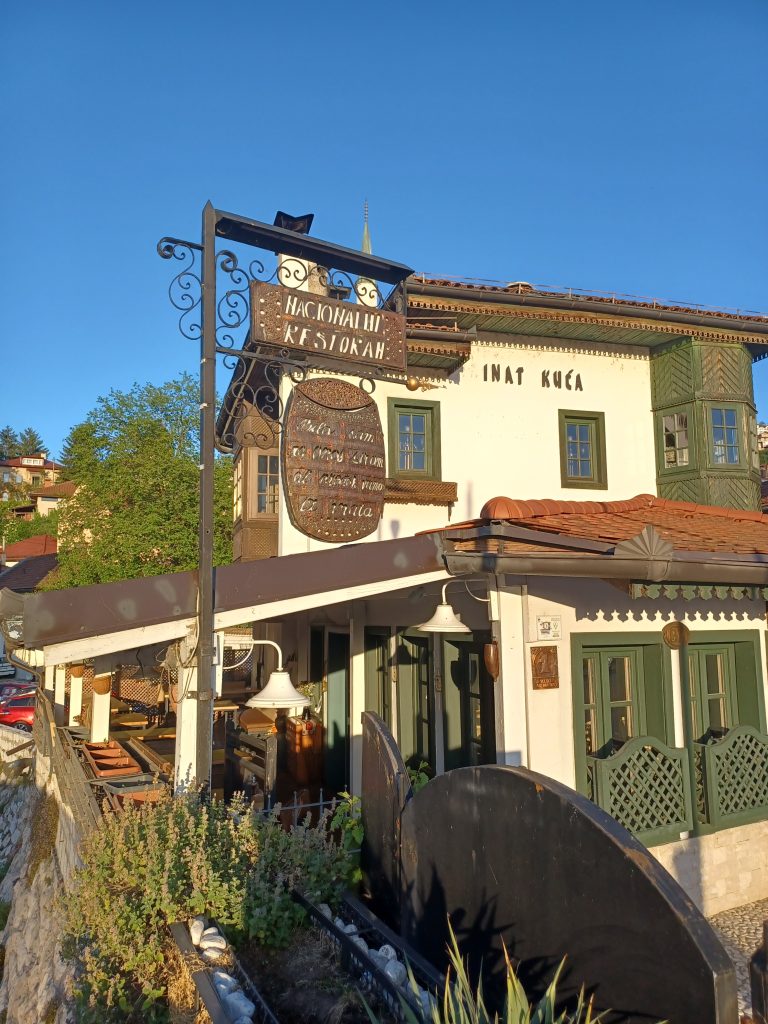
Also on the south bank of the Miljacka river is the Ashkenazi synagogue, built in 1902. Although much of it was destroyed, it survived WW2 but was used as a stable by the Germans. Not many Jews remained in Yugoslavia after the holocaust, around 5,700. Most that survived emigrated to Israel. Our guide told us that there are only a couple of hundred Jews in Sarajevo today.
Scheduled now to rendezvous back at the City Hall, so I wander over the old stone bridge, connecting it to the Spite House. The group is in high spirits. An excellent day has been had by all in this walkable and stimulating city. But tomorrow we are going to witness its recent grim history and visit the Sarajevo War Tunnel or ‘Tunnel of Hope’ built during the siege.
Tunnel of Hope
It is early morning when we turn up at the house belonging to the Kolar family, from where the Tunnel started. It is covered with bullet holes. A plaque reads: ‘The Sarajevo War Tunnel’ and underneath ‘House of the Kolar Family’. The Tunnel was built underneath the airport runway enabling supplies to continue to enter Sarajevo during the siege. It crossed from Butmir on one side to Dobrinja on the other side. After the 44 month siege was over the Kolar family decided to preserve it, managing to retain a 25 metre stretch. On display today are empty shells cases and weapons, as well as tools used in the tunnel’s construction. Maps and diagrams compare the Olympic City in 1984 with the besieged city in 1992-1995. All a bit sobering. Our group proceeds through a replica tunnel, high enough to walk upright, and exits into the free and fresh air.
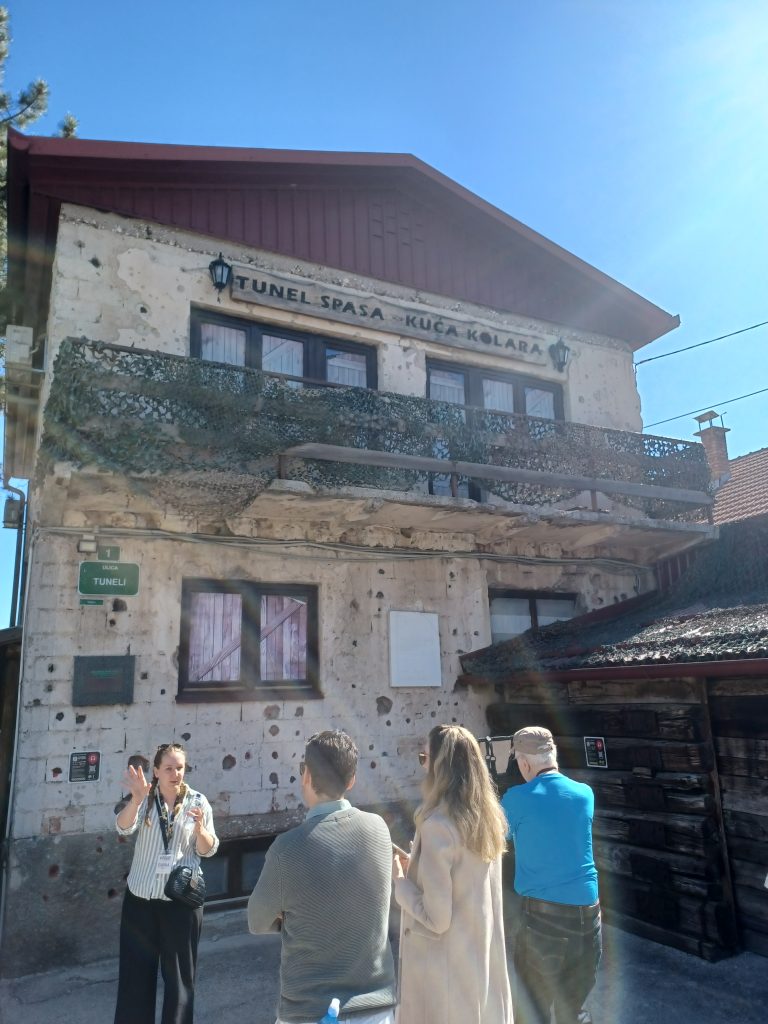
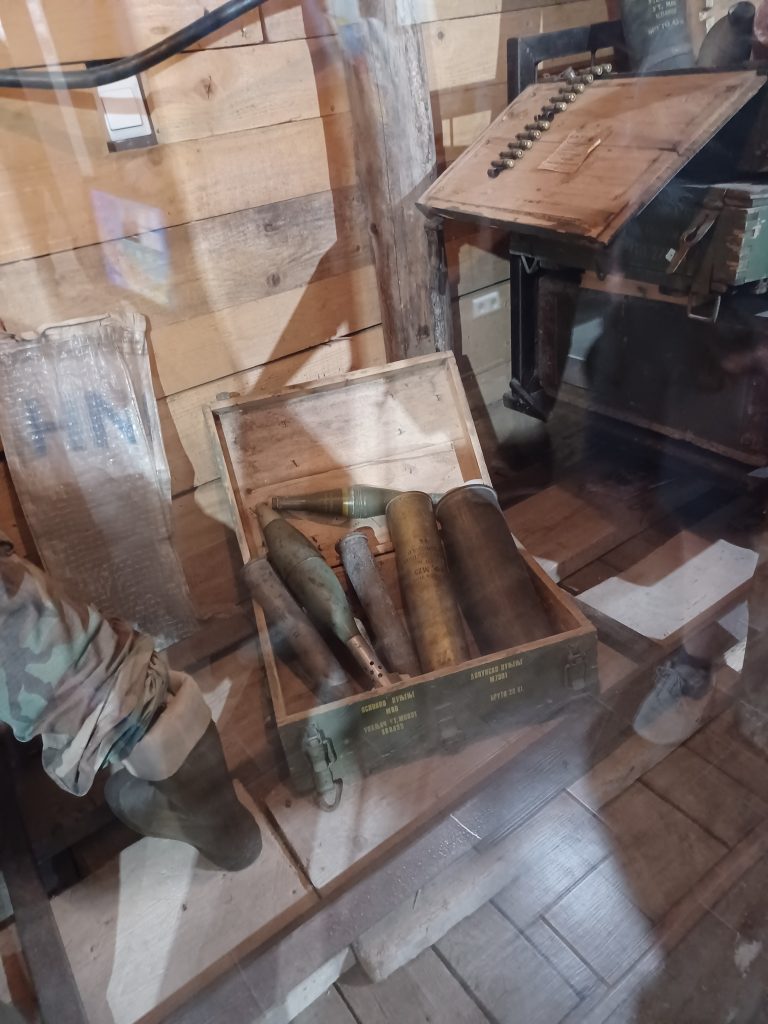
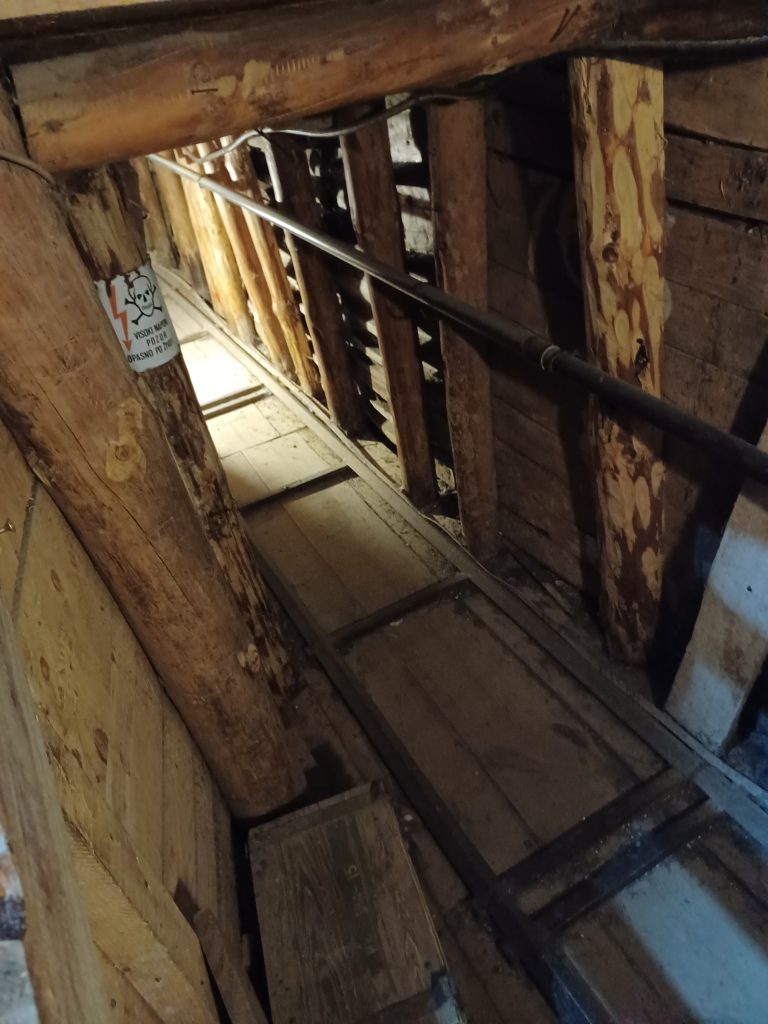
Mostar
Next day sees us heading south-west to Mostar through high forested mountains and valleys. “Tito’s bunker was up here in these mountains”, our guide informs us. “Near Konjic”. The best kept secret for decades, this was. The huge underground fortress existed from the early 1950s until the 1990s when it was revealed behind the façade of a house. “It was strong enough to withstand nuclear weapons” and housed Tito and a few hundred of his retinue. We follow the emerald waters of the Neretva river, “full of trout”, which winds through a deep gorge towards Mostar. We are entering the Herzegovina region from the Bosnia region now and note the Croatian flag flying here representing the majority Croat population. The scenery also changes quite significantly as we encounter a more Mediterranean type vegetation with trees and low scrub and some vines. It is also noticeably hotter.
We pick up the local guide and proceed to the famous ‘Stari Most’, the Mostar bridge.
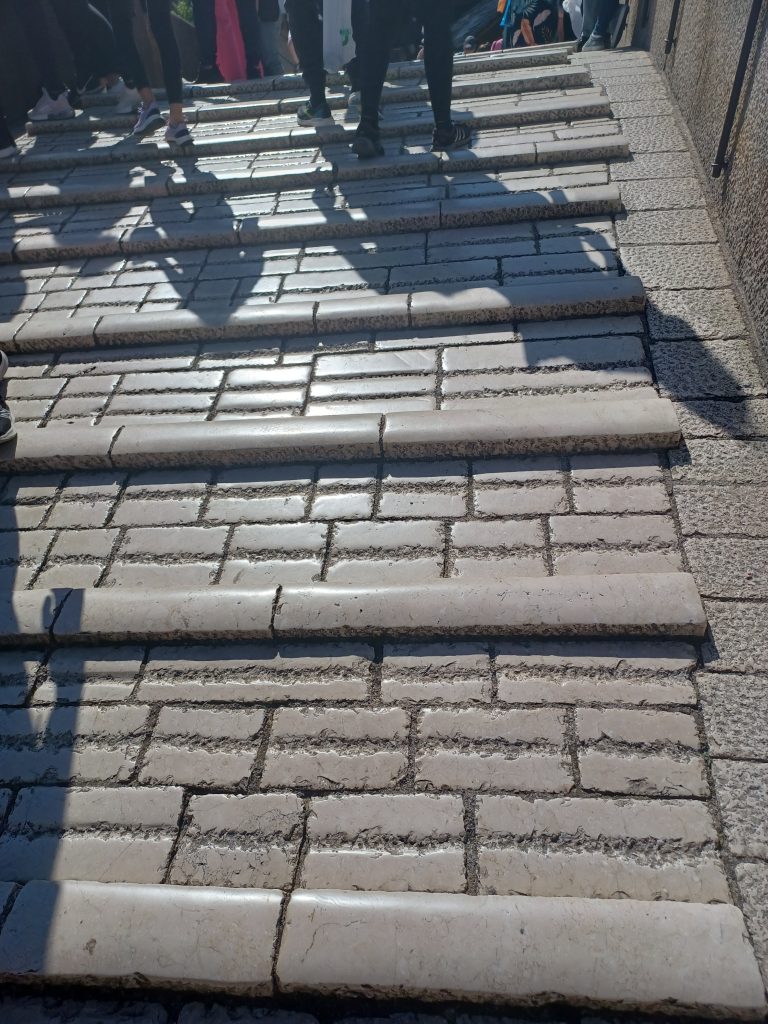
This bridge was deliberately blown up during the war, but has been rebuilt exactly as it was. This is the bridge from which local lads dive or jump into the Neretva river below. “The town of Mostar got its name from the gatekeepers”, says the guide. “They were stationed in the two high forts either side of the bridge, the Mostari”. We cross this high arched bridge. It is quite steep. The stones are very smooth with horizontal ridges along it to prevent the horses slipping, we are told. To prevent humans slipping too. “The stones are more slippery in the heat than the rain”, the guide informs us as we pick our way gingerly over it.
The cobbles in the narrow streets are also tricky to walk on. Small hard rounded cobbles, not much more than pebble size, some of them. Very smooth and shiny from all those tourist feet. There are shops and cafés and restaurants all along the streets, along which tourists flow. The houses are built of the local white stone, a foot thick, and painted. Same on the rooves. Green hills rise all round and the odd minaret.
After the formal tour I head to a road parallel to the cobbled riverside street. It is a lot less busy and here are ruined buildings from the war, left to decay. Some are riddled with bullet holes. Scaffolding supports one building and ferns grow out of the windows. A considerable contrast to the colourful painted houses with shutters. I do not dally.
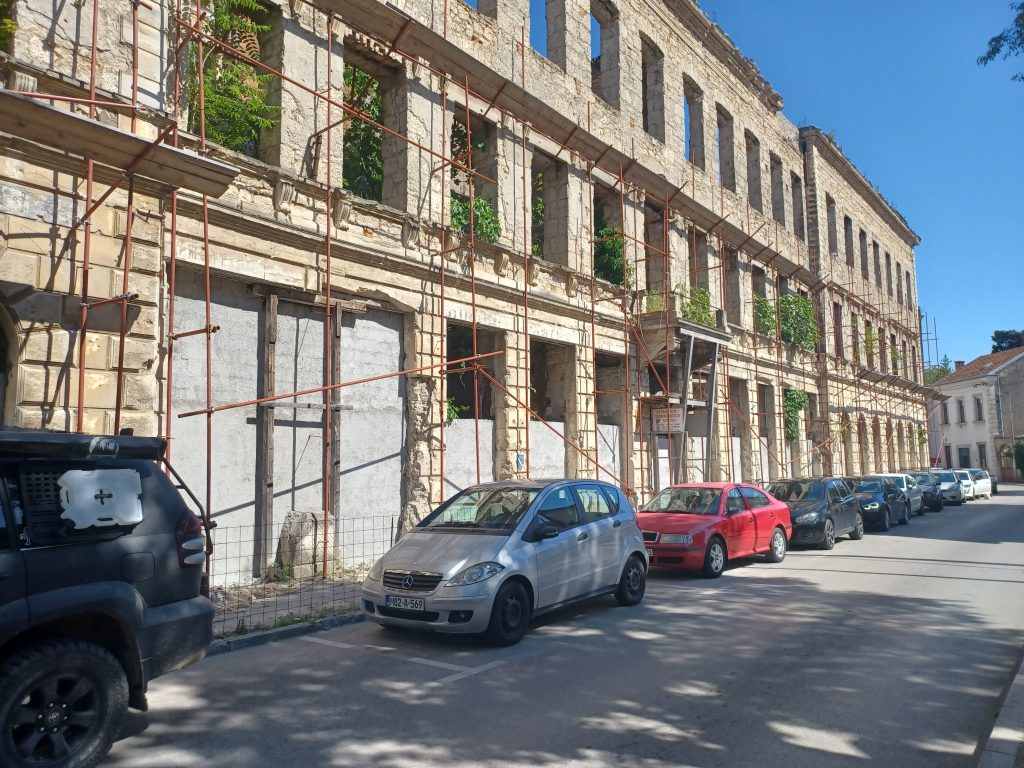
On a couple of levels down the steep sides of the Neretva gorge are arrayed several restaurants with their awnings and sunshades. I inspect a few and finally select a table with a red and white checked tablecloth overlooking the Stari Most. Nobody is jumping off the bridge today but some orange and white inflatable boats are passing underneath at speed. While I stuff myself with stuffed peppers and cabbage leaves washed down with ‘Blatina,’ the local red, I watch the people filing over the bridge, a gatehouse rising tall at the end of it, a minaret behind, pale purple, pale pink, pale yellow houses, and a wind turbine on the hill.
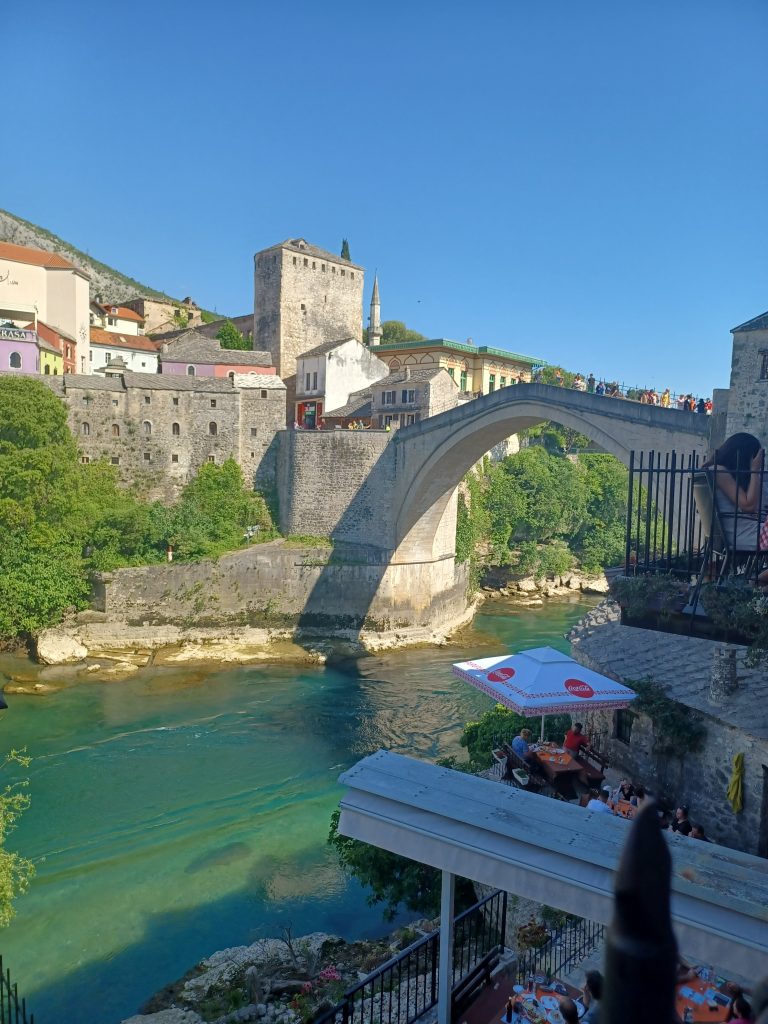
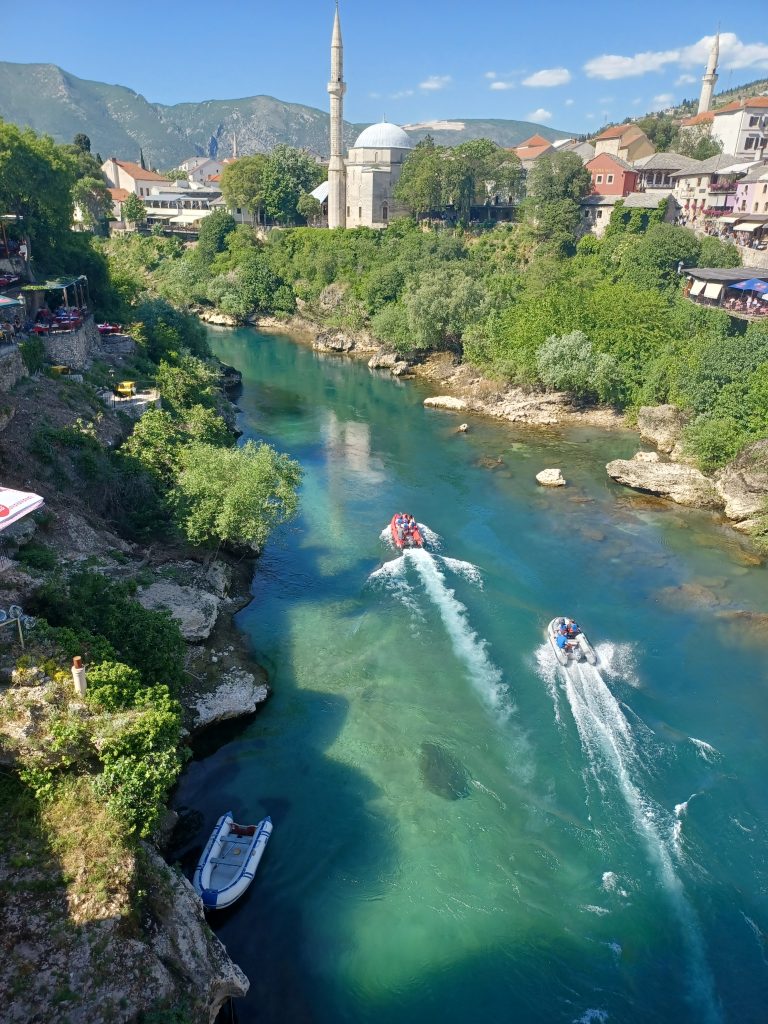
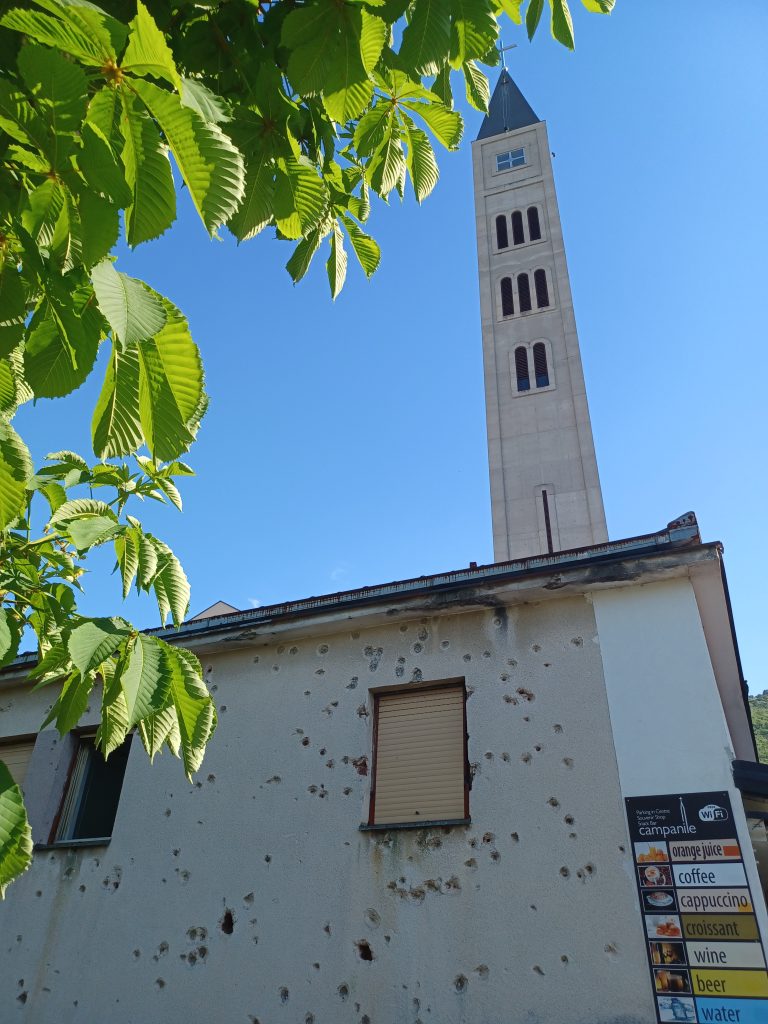
The meeting point for the group is the Mostar Church with its 107.2 metre tall bell tower, the ‘Mostar Peace Bell Tower’, built of concrete in 2000. Separate from the main church building and situated in a less beautiful part of town. It was left in ruins after Mostar was bombarded by Serbs and Montenegrins in 1992. Bullet holes from that time have been left visible on the white concrete wall of the snack bar, ‘Campanile,’ close by. I have a quick glance inside the church, before boarding the coach once again.
The coach heads to Trebinje and our hotel for the night. Thence to our next Balkan country: Croatia.

Leave a Reply